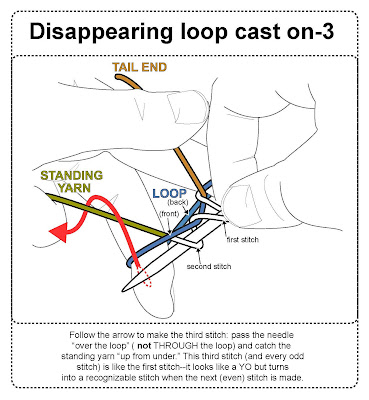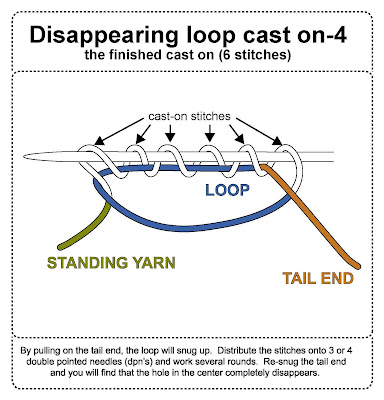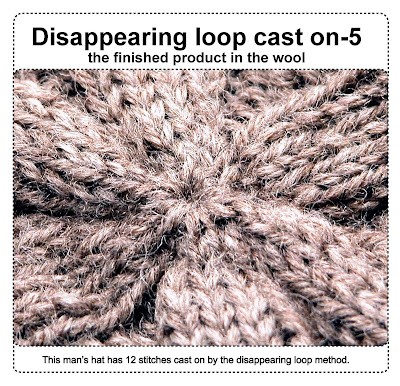For knitted objects started in the middle, (shawl, hat) choose the "disappearing loop" method to cast on. Unlike the famous "Emily Ocker's beginning" of which you may have heard, disappearing loop is superior because:
- There is no slip knot, so there is no hard nub in the middle of your work.
- The first stitches are not crocheted, so they are not larger and heavier than the rest of the work.
HOW TO
1. Make a loop over two fingers of the left hand, as shown. The tail end lies OVER the ball end. In your right hand, hold a double-pointed knitting needle several sizes smaller than you will use for the knitting. Make the first stitch (follow the red arrow) by reaching OVER (not through) the loop, and catching the standing yarn (standing yarn=yarn coming from the ball, also called the "ball end") "up from under" to form a stitch which lies over the needle.
click picture

2. Make the second stitch (follow the red arrow) by reaching THROUGH the loop, catching the standing yarn "up from under" and drawing the standing yarn back out of the loop, to form a stitch which lays over the needle.
click picture

3. Make the third stitch (follow the red arrow) as you made the first one: reach OVER (not through) the loop, and catch the standing yarn "up from under" to form a stitch which lies over the needle. Click here for an explanation of how each finger is deployed in the illustration below.
click picture

4. Continue, making each odd stitch OVER the loop and each even stitch THROUGH the loop and until you have the EVEN number of stitches you need (if you need to cast on an odd numbers of stitches, see point 7, below)
click picture

5. Distribute the stitches onto 3 or 4 dpn and join the work by using the standing yarn to knit through the first stitch cast on. Do not bcome discouraged if the needles drop out--which they WILL do several times, until you finally prevail. (HINT: try different needles until you find the ones which work best for you--bamboo needles are maybe easier for knitting with few stitches where needles are apt to fall out...)
6. After several rounds, tug on the tail end. Ta da! The original loop into which you were working will disappear, and your work will feature a beginning rosette of the even, attractive stitches you worked into that loop. (HINT: give the tail an experimental tug right away, after first joining the work just to be sure the loop CAN tighten and didn't get tangled while making the join. If the tail end did get tangled up, try, try again.)
click picture

7. If, for some reason, you need an ODD number of stitches (a seven-section hat top?) make the loop with the BALL end on top, and make the first (and all odd) stitch(es) by going THROUGH the loop for the first stitch, then OVER the loop for the second (and all even) stitch(es). This way the odd stitch with which you want to end (the last stitch) is "held in" by having been made through the loop.
A final note: Does this sort of cast-on look familiar to you from another context? Perhaps you have used this technique in making a kind of provisional cast on called "invisible cast on." For invisible cast-on, instead of making a loop into which to work, you hold a length of scrap yarn along a straight knitting needle and conduct this same series of manuevers over and under the needle and the scrap yarn. You then withdraw the needle and leave the loops on the scrap yarn until you're ready to expose the stitches. When you withdraw the scrap yarn, you'll see live loops, waiting to be knitted up.
However, IMHO, there exists a far better provisional cast-on (illustrated here) so I'd save this trick for working into a "disappearing loop" for center-started knitting.
ADDENDUM September 2009: As beautiful as this cast-on is, some folks have been having a hard time following the diagrams. In real life, you could learn this trick in 5 minutes, but it IS hard to learn from diagrams, no doubt about it. At any rate, if you like the look of disappearing loop, but are having a hard time of it, then click over to this post: Knitting from the center--belly buttons and the umbilical waste cord method." Although they do take a little longer, knitted belly buttons end up with the same structure and look as disappearing loop, and are easier to learn from diagrams.
ADDENDUM April 2017: Here is a video from a reader, Judy Vallas, showing how to do this cast on.
--TECHknitter
ADDENDUM April 2017: Here is a video from a reader, Judy Vallas, showing how to do this cast on.
--TECHknitter